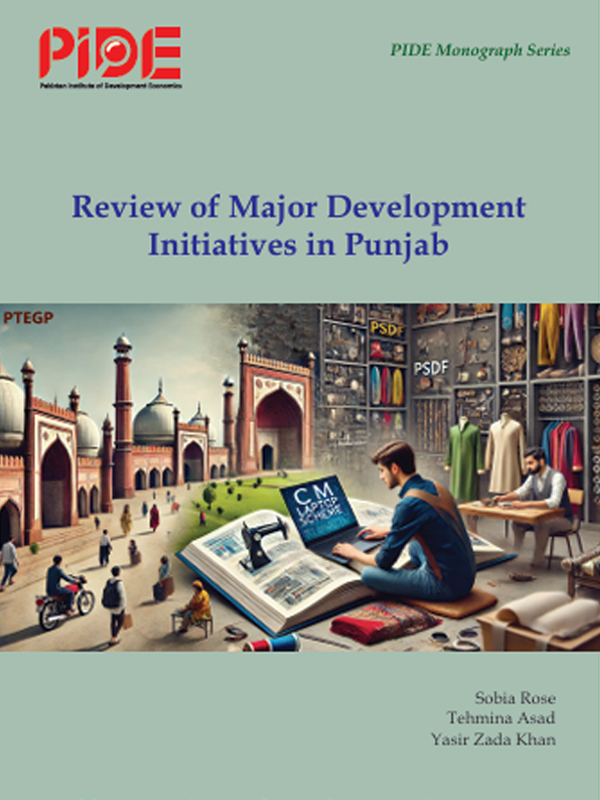
Pakistan Institute of Development Economics
- Home
Our Portals
MenuMenuMenuMenuMenuMenuMenu - ResearchMenuMenuMenuMenuMenuMenuMenu
- Discourse
- The PDR
- Our Researchers
- Academics
- Degree Verification
- Thesis Portal
- Our Portals
Review Of Major Development Initiatives In Punjab
INTRODUCTION TO MONOGRAPH
The Government of Punjab allocates a significant proportion of its budget to different development projects managed by the Planning and Development Board (P&D). Analyzing the processes and workings of the projects provides valuable insights that can be used to improve future initiatives, making development efforts more effective over time. Lessons learned from one project can inform the design and implementation of subsequent initiatives, leading to better outcomes and enhanced decision-making for future projects. To achieve these goals the Planning and Development Board of the Government of Punjab requested Pakistan Institute of Development Economics to evaluate its three projects, Chief Ministers’ Laptop Scheme, Punjab Skills Development Fund (PSDF), and Punjab Tourism for Economic Growth Project. The evaluation of these projects is given in three chapters respectively.
In chapter 1 a comprehensive review of the Chief Minister’s Laptop Scheme is presented, with the primary aim of evaluating its process from initiation to completion. This evaluation offers valuable insights for future similar initiatives, especially in light of the government’s recent launch of a major new scheme with a significant budget allocation. The assessment is based on three key criteria: relevance, efficiency, and effectiveness. Relevance is evaluated by analyzing the project’s necessity and how well its objectives align with the needs of the beneficiaries. Efficiency is measured considering how economically resources like funds, expertise, and time are converted into results. This analysis focuses on indicators such as the rate and timeliness of actions, procedural issues, product quality, and comparisons with international practices for similar interventions. Scheme’s effectiveness is assessed based on digital skills transfer, ICT adoption, access and quality of internet facilities, spatial penetration of ICT, and laptop utilization.
The evaluation of the operational efficiency of the Punjab Skill Development Fund (PSDF) in given in chapter 2 which focuses on its administrative procedures, program benefits, information dissemination, and management practices. The key objectives include assessing the necessity for the fund, understanding its structure and functioning, evaluating trainee selection criteria, and analyzing the relevance and sustainability of various training programs. The study highlights that the PSDF has trained over 500,000 individuals, including a substantial percentage of women, and developed a vast network of over 700 training partners across Punjab. The PSDF’s model, based on public-private partnerships, emphasizes employment and income-generation outcomes, results-based payments to training providers, and a competitive bidding process for training partners. This study provides insights into the PSDF’s processes and mechanisms, highlighting the significance of improving transparency, ensuring cost-effectiveness, and developing sustainable funding models. While the PSDF has made notable achievements in skill development and employability, addressing the identified challenges is crucial for its future success and the sustained economic empowerment of the youth in Punjab.
The Punjab Tourism for Economic Growth Project (PTEGP), i.e. a World Bank funded project for the Government of Punjab. The evaluation of this program is discussed in chapter 3. The primary objectives were to assess the progress of PTEGP in facilitating tourism development in Punjab and to analyze the disbursement of funds, while also examining stakeholder perceptions within the tourism industry regarding the project’s interventions. The study utilized various methodologies, including a review of pertinent project documents, analysis of surveys conducted by PTEGP, assessments of project component revisions by the steering committee, an examination of the tourism landscape in Punjab, and calculations of tourist footfall and spending patterns at project sites. Insights were also gathered from stakeholders directly or indirectly associated with PTEGP’s interventions in the tourism sector.



